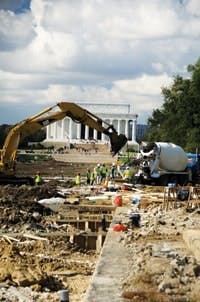Washington, D.C., is home to some of the U.S.’ most prized and revered memorials. To the nearly 24 million people who visited the mall in 2011, the Reflecting Pool appeared to be more of a science project than a scenic and iconic historic stop.
Several key improvements were needed to keep the largest and most famous reflecting pool in the capital sustainable for years to come. The pool, originally constructed in the early 1920s, had been relatively untouched in terms of improvements since its completion. It was prone to leaking and holding stagnant water, and called upon the city’s drinking water resources to fill the pool with nearly 20 to 30 million gal per year.
The Louis Berger Group Inc. served as the consulting firm offering engineering, architecture and other development resources for the project. When drafting solutions to the reflecting pool’s problems, engineers chose a series of unique methods. The $30.7-million project’s goals included:
- • Replacing the leaking concrete pool;
- • Retaining the original coping stones of the pool;
- • Installing a high-density polyethylene (HDPE) pipeline and filtration system for drawing water from the Tidal Basin rather than using city water;
- • Installing a system for cleaning and recirculating the water;
- • Installing new, wider sidewalks adjacent to the pool to replace the dirt paths;
- • Resurfacing the Elm Walks on the north and south sides of the pool;
- • Adding new lights and benches; and
- • Improving accessibility and security measures.
The project is the National Park Service’s largest to use American Recovery and Reinvestment Act of 2009 funds. It commenced in November 2010, revolving around approximately 2,400 wooden pilings that were driven into the ground until hitting the bedrock 40 to 50 ft below. The timber pilings were spaced apart every 12 ft 9 in. throughout the 2,029-ft-long pool. The piles were used for the foundation design due to the presence of compressible fill materials beneath the Reflecting Pool, which was built on Tidal Basin sediments.
“The pile foundation was designed to accom- modate the pool slab, water weight and crowd surge load,” said James Stroup, P.E., LEED AP, technical project manager for Louis Berger Group “Previously, the Reflecting Pool slab was not supported on piles, and, as a result had settled, cracked and separated from the pile-supporting coping stone.”
In addition to the challenges of strategically hammering yellow pine timbers into the ground, workers were required to remove, repair and restore the 586 granite coping stones located around the pool. The stones, still in place from the 1922 construction, were restored in their original location as part of a historical preservation process.
Pipe Selection
While the unique piling system solved the issue of supporting the 12,000 cu yd of concrete for the new pool, the question remained of which infrastructure to install in order to support the water within the new renovated design.
One of the key project requirements set forth by the National Park Service was sustainability.
“It was not considered sustainable or environmentally sound to use water treated to drinking water quality to fill the Reflecting Pool, especially given the volume required,” Stroup said. “Even with the reduced volume of the redesigned pool, this seemed like an avoidable waste of a valuable and limited resource. In order to design a more sustainable site, a primary design objective was to find alternate water sources to fill the Reflecting Pool. After performing a life-cycle cost analysis, Tidal Basin water with filtration and disinfection was found to be the most viable option.”
The water in the pool will not be safe for human consumption, but by filtering and disinfecting the Tidal Basin water, the pool will attain the clear water required to achieve the same reflection of the past. Engineers also kept the piping connection between the Reflecting Pool and the city’s water supply, should it be needed as an alternative source or for cleaning purposes.
HDPE was chosen for the water supply and circulation system for the Reflecting Pool after considering several factors. “Once correctly welded via butt fusion or electrofusion, HDPE joints are considered completely restrained,” Stroup said. “This was particularly important, as many of the lines will be located beneath the Reflecting Pool and will not be accessible.”
Other pipe materials were considered for the project, but HDPE was proven to be the best fit given the constraints of the project and environmental conditions. Looking at costs, the material and installation of HDPE was even with polyvinyl chloride (PVC) and ductile iron (DI). Yet another site constraint was that the pool sits on a former marsh- land, which lends itself to differential settlement on an unsupported infrastructure. HDPE’s flexibility was a key factor to combat this possibility, due to its ability to tolerate potential dif- ferential settlement without breaking.
The final factor in HDPE’s selection was that the pipe material will reportedly not tuberculate or support biological growth.
Pipe Fusion
To fuse the more than three miles of HDPE pipe to be installed under the Reflecting Pool and to the Tidal Basin, Corman Construction enlisted the help of Ferguson Industrial Plastics, which recommended a range of McElroy pipe fusion products to be used on the project. Consultants from Ferguson also provided training and qualification testing of Corman Construction personnel to perform the pipe fusion process.
The two key fusion machines used were the Rolling 28 and Pit Bull 14.
“We have four different foremen and five other workers who are qualified to fuse pipe,” said Tom Mulcahy, project engineer for Corman Construction. “I found working with polyethylene very easy. We’ve done [fusions] from 2- to 12-in. on the job. The fusing doesn’t take that long, so it’s nice to be able to fuse in this manner.”
Under the Reflecting Pool, 3- and 4-in. piping is most prevalent. That pipe connects with increasing larger-diameter pipe to reach the water treatment building. A 10-in. line con- nects the Tidal Basin to the water treatment facility.
The Lincoln Memorial Reflecting Pool has been a sacred memorial to the American people since its origi- nal construction in the early 1920s. With the use of HDPE, a piping material capable of lasting more than 100 years, its latest renovation will be sustainable for generations to come.
Download: Here



